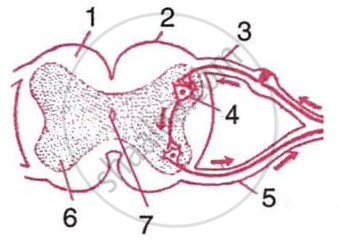Advertisements
Advertisements
Question
Give the functions of medulla.
Solution
The medulla controls various involuntary actions such as the heart beat, breathing, blood pressure and peristaltic movements of the alimentary canal.
APPEARS IN
RELATED QUESTIONS
Write the names of the regions in hindbrain. Give one function of each region.
A cylindrical structure P in our body begins in continuation with medulla and extends downwards. It is enclosed in a bony cage Q and surrounded by membranes R. As many as x pairs of nerves arise from the structure P. The structure P is involved in the reflex actions of our body and conduction of nerve impulses to and from another organ S of our body with which it forms CNS.
(a) Name the structure P.
(b) Name (i) bony cage Q, and (ii) membranes R.
(c) How much is x?
(d) Name the organs S.
(e) What are the reflexes involving structure P only known as?
Note the relationship between the first two words and suggest the suitable word/words for the fourth place.
Stimulus : Receptor :: Impulse : ______.
Complete the following statement by choosing the correct alternative from the choice given in bracker:
Reflex action is controlled by
(i) brain (ii) spinal cord
(iii) autonomic (iii) peripheral nervous system
State whether the following is simple reflex, conditioned reflex or neither of the two:
Lifting up a book: …………………..
In reflex action, the reflex arc is formed by ______
What will you do if someone pricks your hand with a needle? Elucidate the pathway of response with a neat labelled diagram.
Which sensory organ is involved in vertigo (sensation of oneself or objects spinning around)?
Given alongside is a partial diagrammatic representation of a certain phenomenon pertaining to the nervous system.
 |
- Name the parts numbered 1-7.
- Name the phenomenon that the diagram depicts and define it.
- Give the technical term for the point of contact between two nerve cells.
- Name the parts not shown in the diagram that should be included to complete the pathway of the phenomenon.
